13 KiB
| categories | date | thumbnail | usePageBundles | tags | title | ||
|---|---|---|---|---|---|---|---|
| VMware | 2021-03-29T08:34:30Z | VZaK4btzl.png | true |
|
vRA8 Custom Provisioning: Part One |
I recently shared some details about my little self-contained VMware homelab as well as how I integrated {php}IPAM into vRealize Automation 8 for assigning IPs to deployed VMs. For my next trick, I'll be crafting a flexible Cloud Template and accompanying vRealize Orchestrator workflow that will help to deploy and configure virtual machines based on a vRA user's input. Buckle up, this is going to be A Ride.
Objectives
Before getting into the how it would be good to start with the what - what exactly are we hoping to accomplish here? For my use case, I'll need a solution which can:
- use a single Cloud Template to provision Windows VMs to one of several designated compute resources across multiple sites.
- generate a unique VM name which matches a defined naming standard.
- allow the requester to specify which site-specific network should be used, and leverage {php}IPAM to assign a static IP.
- pre-stage a computer account in Active Directory in a site-specific Organizational Unit and automatically join the new computer to the domain.
- create a static record in Microsoft DNS for non-domain systems.
- expand the VM's virtual disk and extend the volume inside the guest based on request input.
- add specified domain accounts to the guest's local Administrators group based on request input.
- annotate the VM in vCenter with a note to describe the server's purpose and custom attributes to identify the responsible party and originating ticket number.
Looking back, that's kind of a lot. I can see why I've been working on this for months!
vSphere setup
In production, I'll want to be able to deploy to different computer clusters spanning multiple vCenters. That's a bit difficult to do on a single physical server, but I still wanted to be able to simulate that sort of dynamic resource selection. So for development and testing in my lab, I'll be using two sites - BOW and DRE. I ditched the complicated "just because I can" vSAN I'd built previously and instead spun up two single-host nested clusters, one for each of my sites:
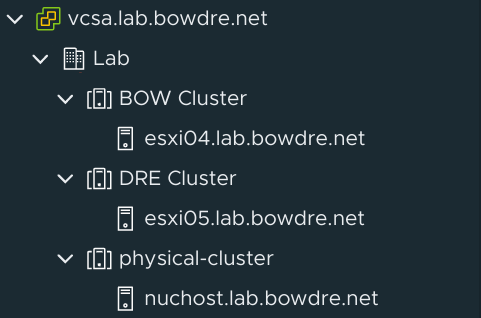
Those hosts have one virtual NIC each on a standard switch connected to my home network, and a second NIC each connected to the "isolated" internal lab network with all the VLANs for the guests to run on:
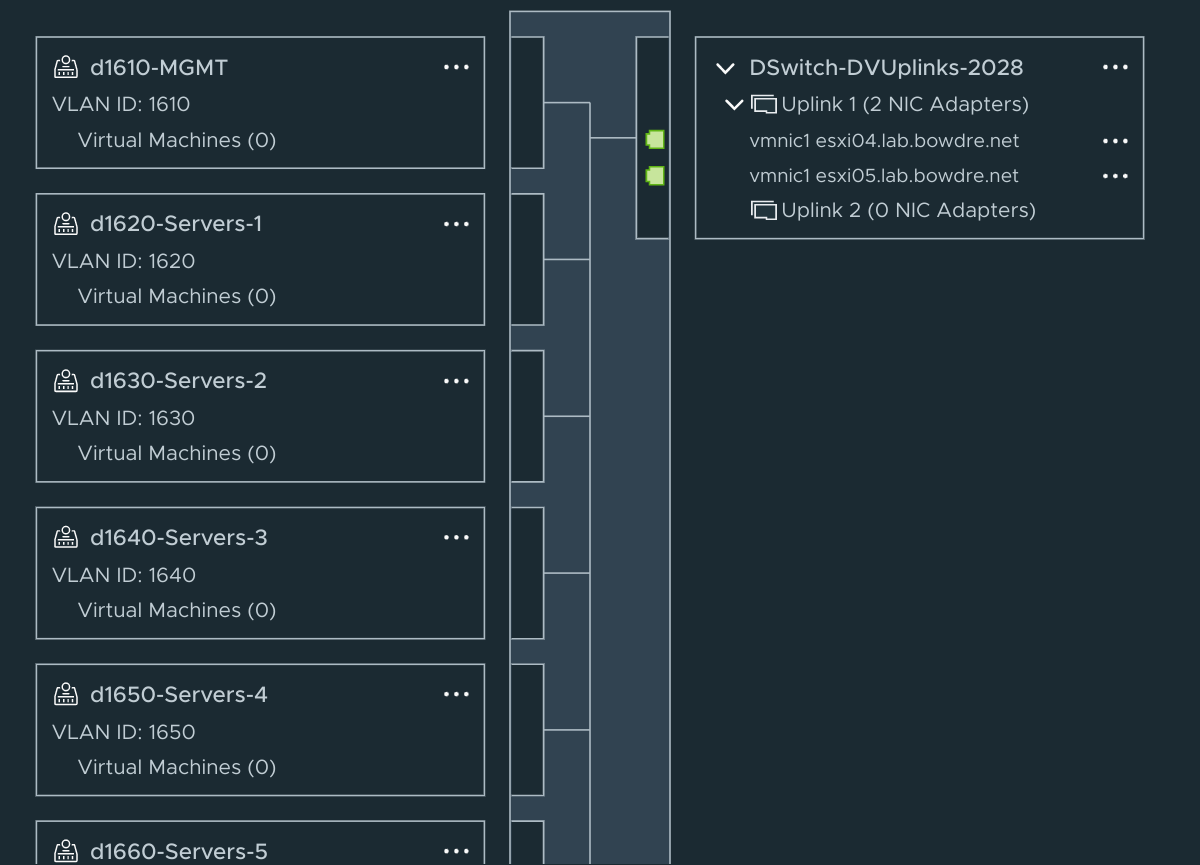
vRA setup
On the vRA side of things, I logged in to the Cloud Assembly portion and went to the Infrastructure tab. I first created a Project named LAB, added the vCenter as a Cloud Account, and then created a Cloud Zone for the vCenter as well. On the Compute tab of the Cloud Zone properties, I manually added both the BOW and DRE clusters.
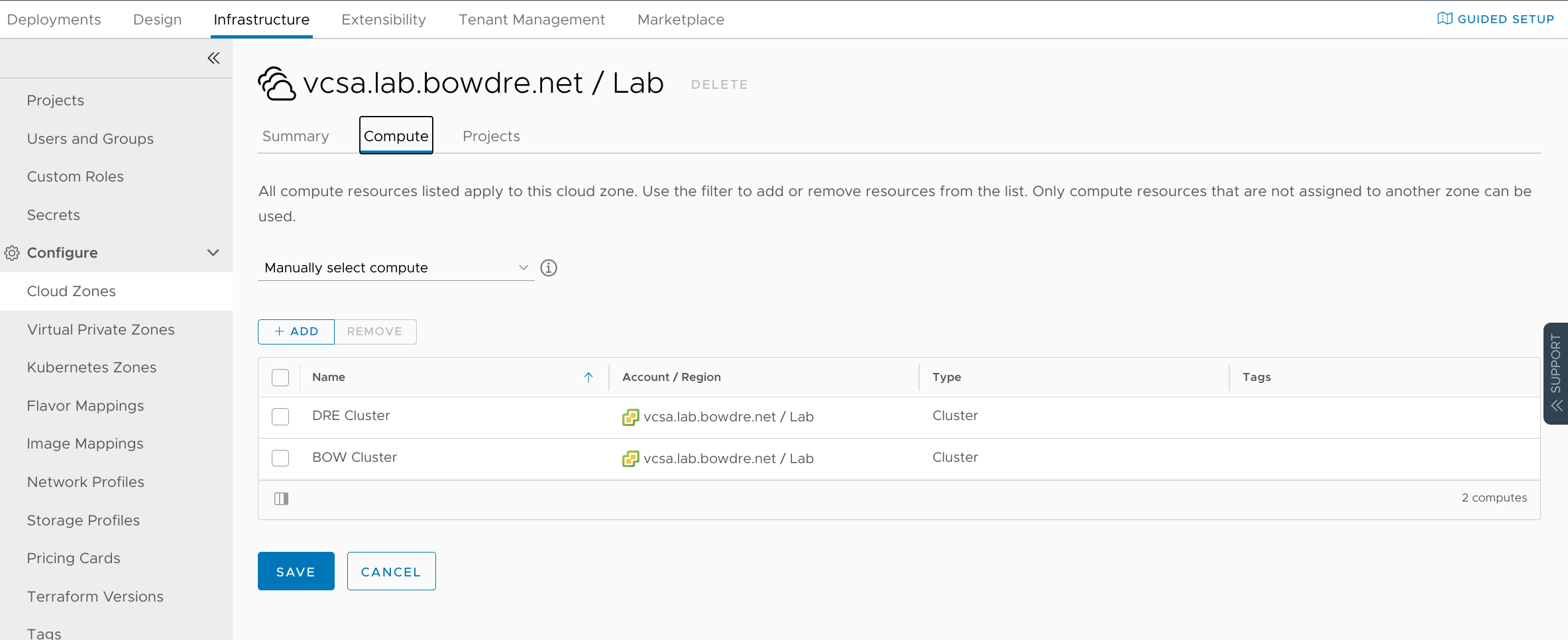
I also created a Network Profile and added each of the nested dvPortGroups I had created for this purpose.
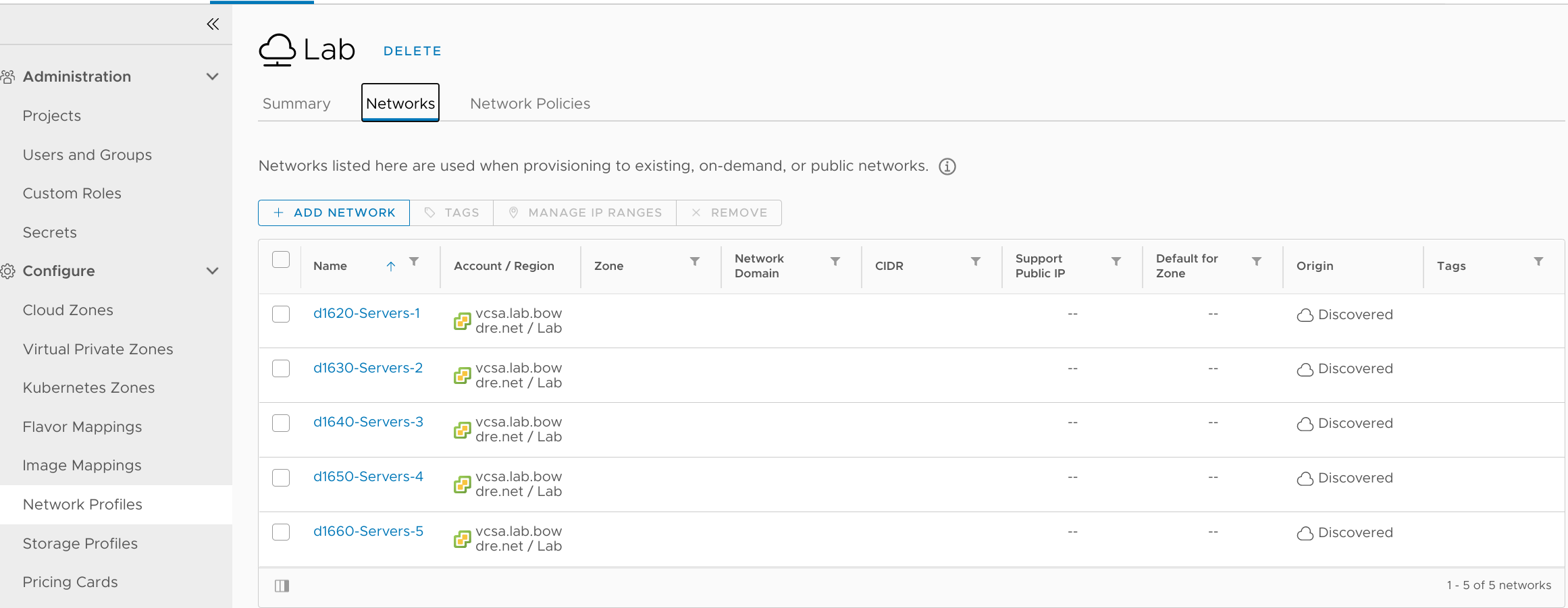
Each network also gets associated with the related IP Range which was imported from {php}IPAM.

Since each of my hosts only has 100GB of datastore and my Windows template specifies a 60GB VMDK, I went ahead and created a Storage Profile so that deployments would default to being Thin Provisioned.
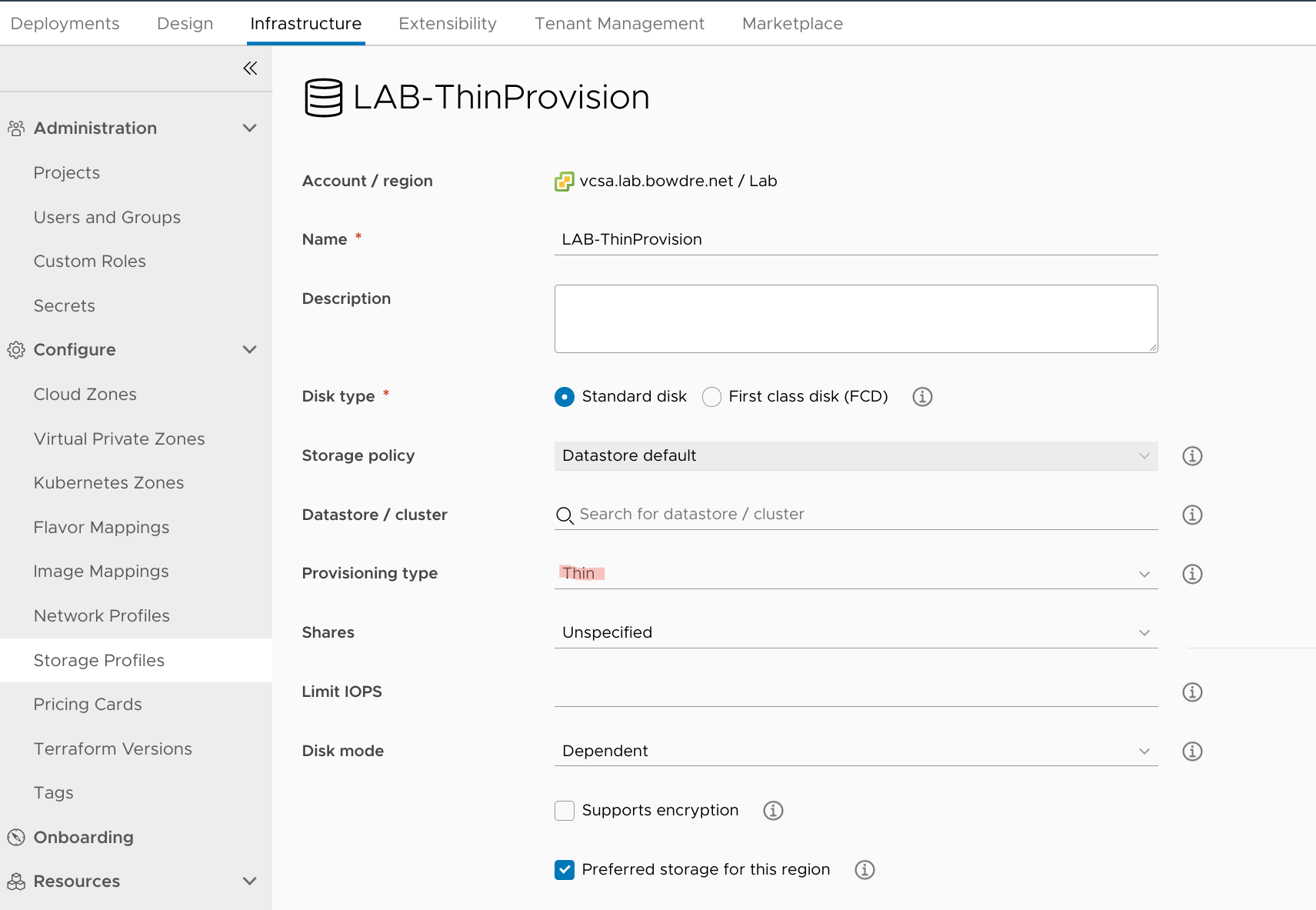
I created a few Flavor Mappings ranging from micro (1vCPU|1GB RAM) to giant (8vCPU|16GB) but for this resource-constrained lab I'll stick mostly to the micro, tiny (1vCPU|2GB), and small (2vCPU|2GB) sizes.
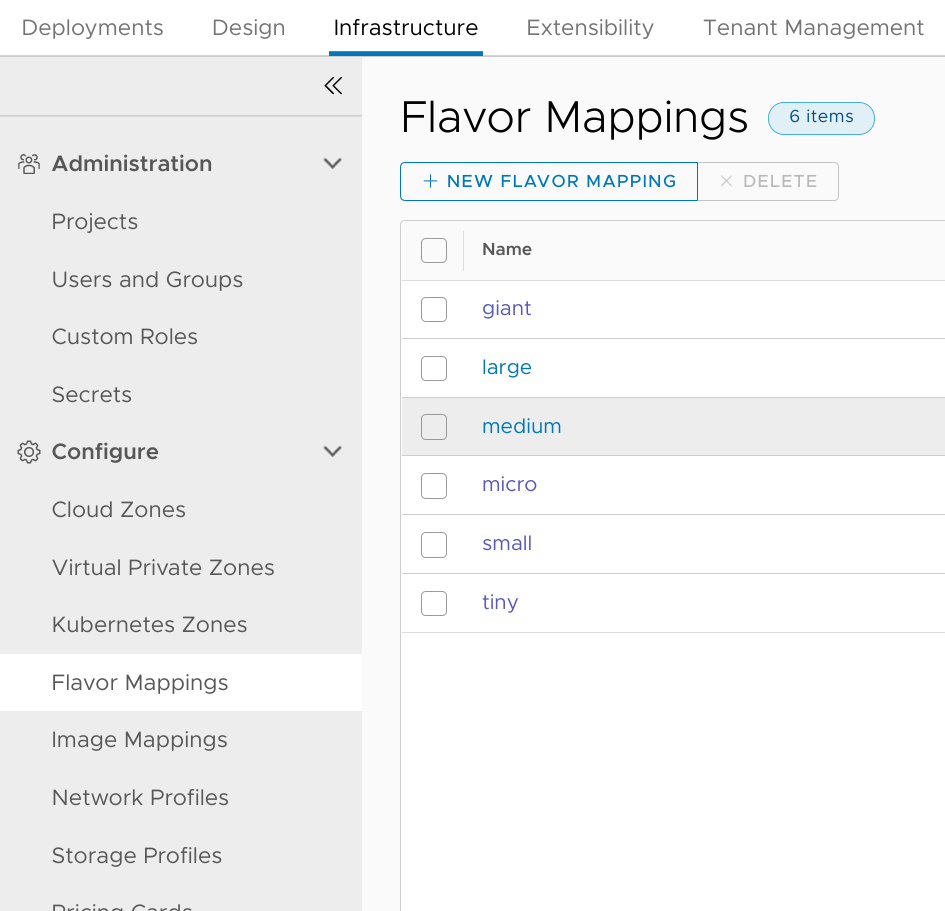
And I created an Image Mapping named ws2019 which points to a Windows Server 2019 Core template I have stored in my lab's Content Library (cleverly-named "LABrary" for my own amusement).
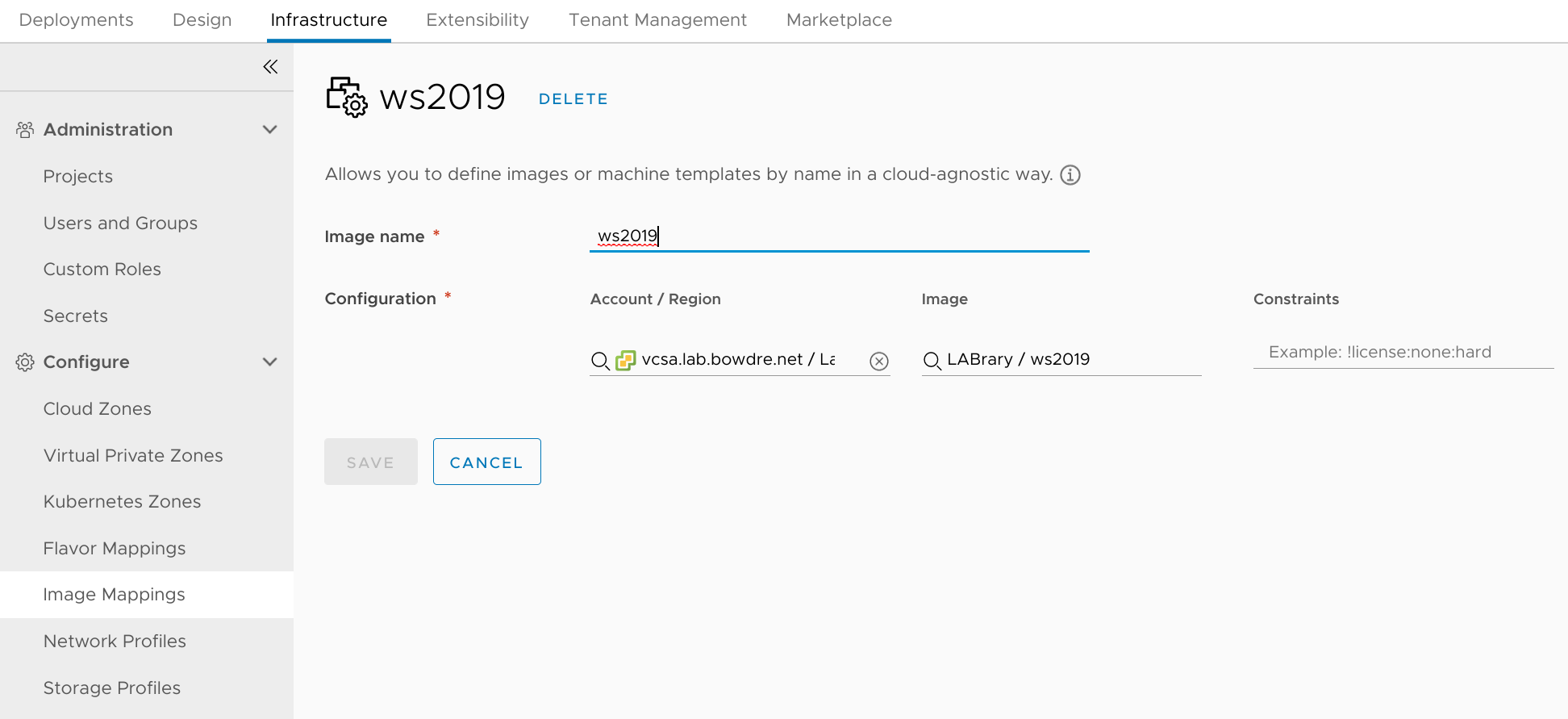
And with that, my vRA infrastructure is ready for testing a very basic deployment.
My First Cloud Template
Now it's time to leave the Infrastructure tab and visit the Design one, where I'll create a new Cloud Template (what previous versions of vRA called "Blueprints"). I start by dragging one each of the vSphere > Machine and vSphere > Network entities onto the workspace. I then pop over to the Code tab on the right to throw together some simple YAML statements:
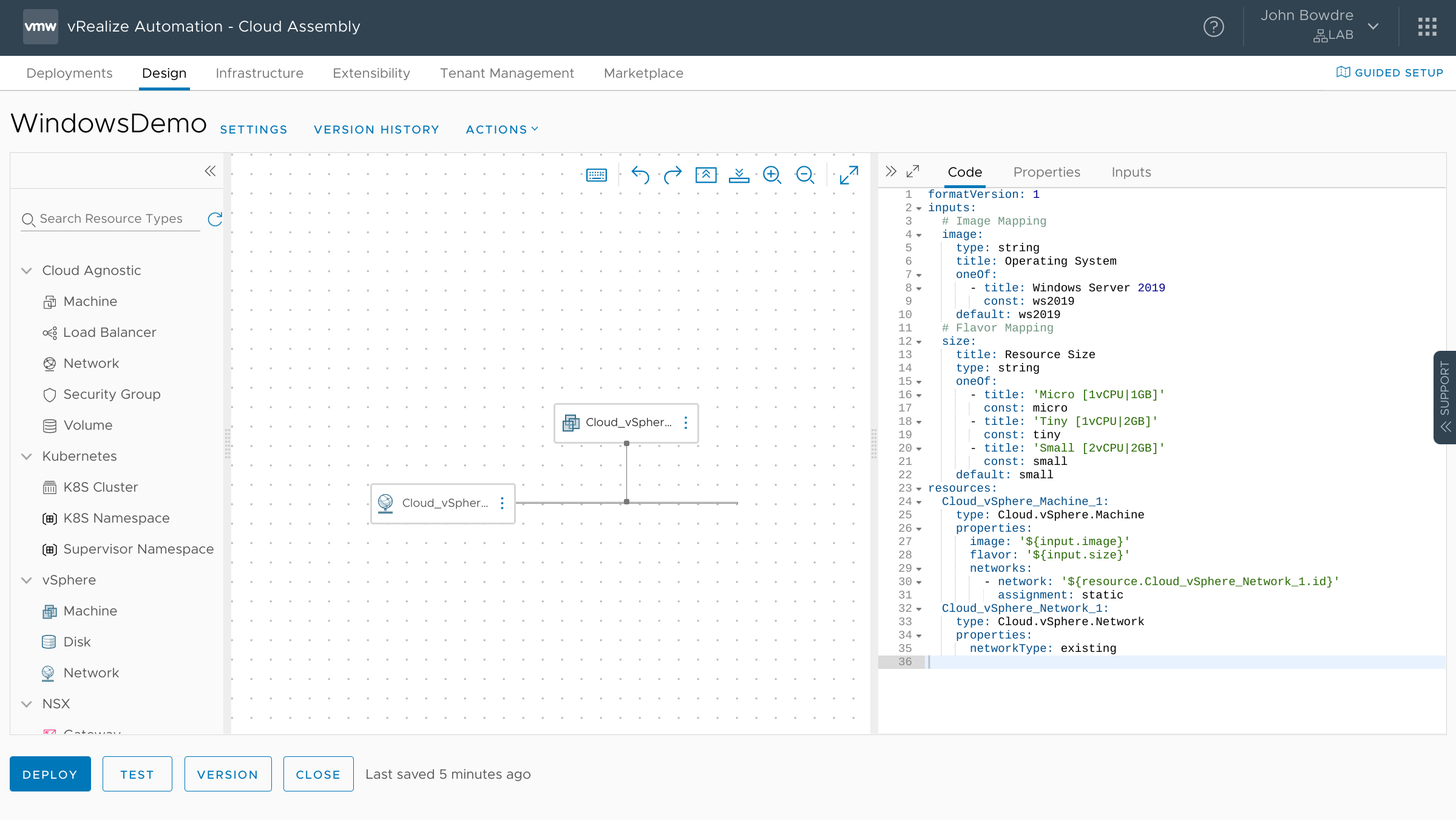
VMware's got a pretty great document describing the syntax for these input properties, plus a lot of it is kind of self-explanatory. Let's step through this real quick:
# torchlight! {"lineNumbers": true}
formatVersion: 1
inputs:
# Image Mapping
image:
type: string
title: Operating System
oneOf:
- title: Windows Server 2019
const: ws2019
default: ws2019
formatVersion is always gonna be 1 so we'll skip right past that.
The first input is going to ask the user to select the desired Operating System for this deployment. The oneOf type will be presented as a dropdown (with only one option in this case, but I'll leave it this way for future flexibility); the user will see the friendly "Windows Server 2019" title which is tied to the ws2019 const value. For now, I'll also set the default value of the field so I don't have to actually click the dropdown each time I test the deployment.
# torchlight! {"lineNumbers": true}
# Flavor Mapping
size:
title: Resource Size
type: string
oneOf:
- title: 'Micro [1vCPU|1GB]'
const: micro
- title: 'Tiny [1vCPU|2GB]'
const: tiny
- title: 'Small [2vCPU|2GB]'
const: small
default: small
Now I'm asking the user to pick the t-shirt size of the VM. These will correspond to the Flavor Mappings I defined earlier. I again chose to use a oneOf data type so that I can show the user more information for each option than is embedded in the name. And I'm setting a default value to avoid unnecessary clicking.
The resources section is where the data from the inputs gets applied to the deployment:
# torchlight! {"lineNumbers": true}
resources:
Cloud_vSphere_Machine_1:
type: Cloud.vSphere.Machine
properties:
image: '${input.image}'
flavor: '${input.size}'
networks:
- network: '${resource.Cloud_vSphere_Network_1.id}'
assignment: static
Cloud_vSphere_Network_1:
type: Cloud.vSphere.Network
properties:
networkType: existing
So I'm connecting the selected input.image to the Image Mapping configured in vRA, and the selected input.size goes back to the Flavor Mapping that will be used for the deployment. I also specify that Cloud_vSphere_Machine_1 should be connected to Cloud_vSphere_Network_1 and that it should use a static (as opposed to dynamic) IP address. Finally, vRA is told that the Cloud_vSphere_Network_1 should be an existing vSphere network.
All together now:
# torchlight! {"lineNumbers": true}
formatVersion: 1
inputs:
# Image Mapping
image:
type: string
title: Operating System
oneOf:
- title: Windows Server 2019
const: ws2019
default: ws2019
# Flavor Mapping
size:
title: Resource Size
type: string
oneOf:
- title: 'Micro [1vCPU|1GB]'
const: micro
- title: 'Tiny [1vCPU|2GB]'
const: tiny
- title: 'Small [2vCPU|2GB]'
const: small
default: small
resources:
Cloud_vSphere_Machine_1:
type: Cloud.vSphere.Machine
properties:
image: '${input.image}'
flavor: '${input.size}'
networks:
- network: '${resource.Cloud_vSphere_Network_1.id}'
assignment: static
Cloud_vSphere_Network_1:
type: Cloud.vSphere.Network
properties:
networkType: existing
Cool! But does it work? Hitting the Test button at the bottom right is a great way to validate a template before actually running a deployment. That will confirm that the template syntax, infrastructure, and IPAM configuration is all set up correctly to support this particular deployment.
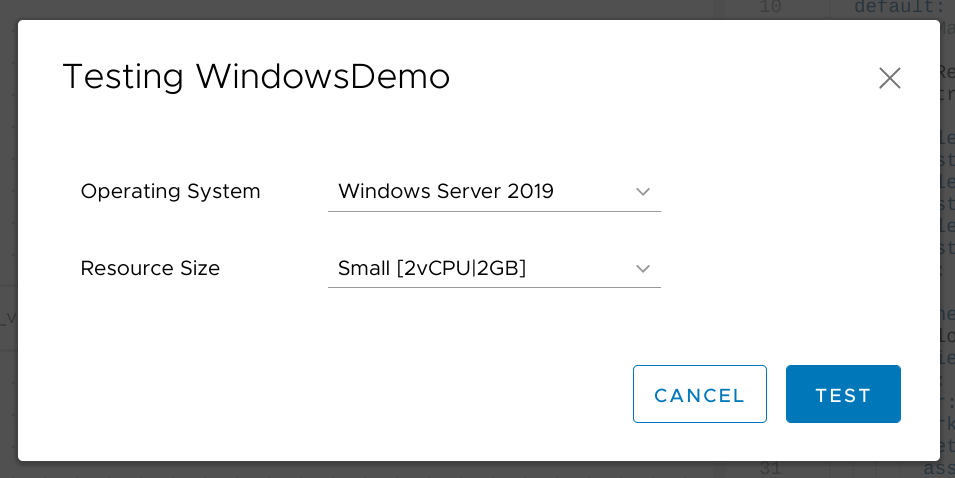
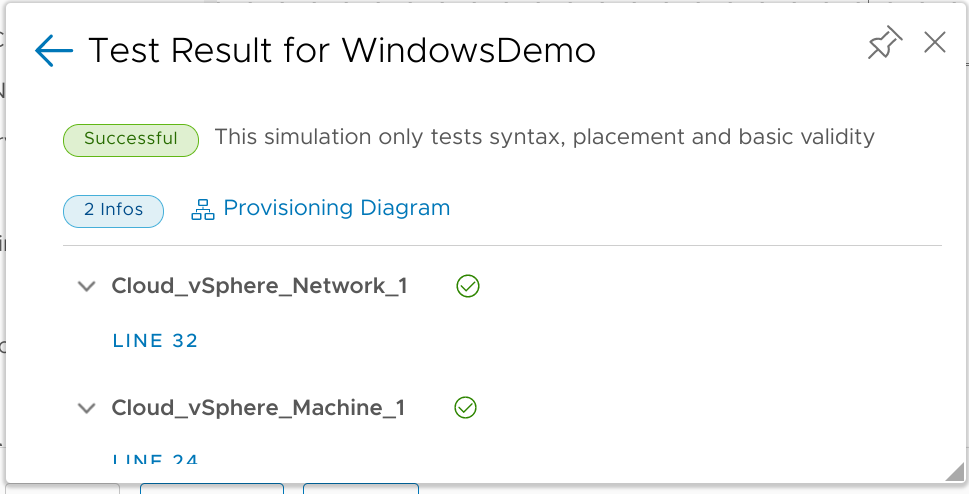
Looks good! I like to click on the Provisioning Diagram link to see a bit more detail about where components were placed and why. That's also an immensely helpful troubleshooting option if the test isn't successful.
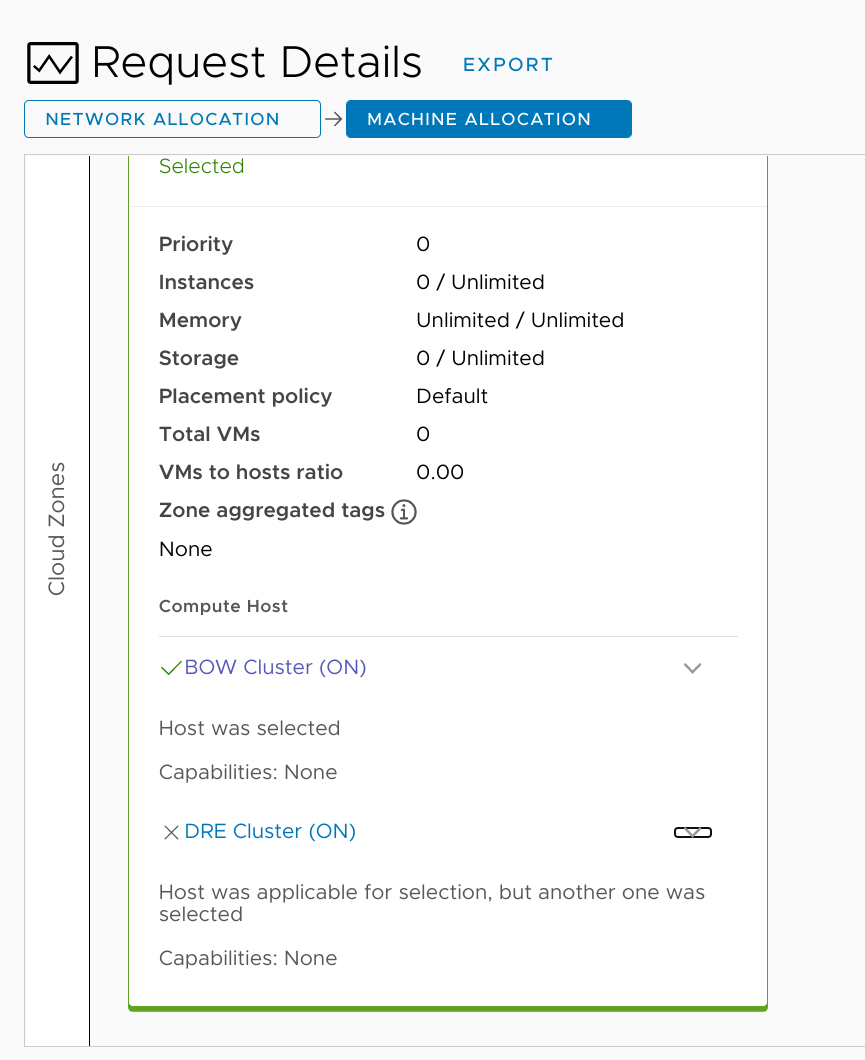
And finally, I can hit that Deploy button to actually spin up this VM.
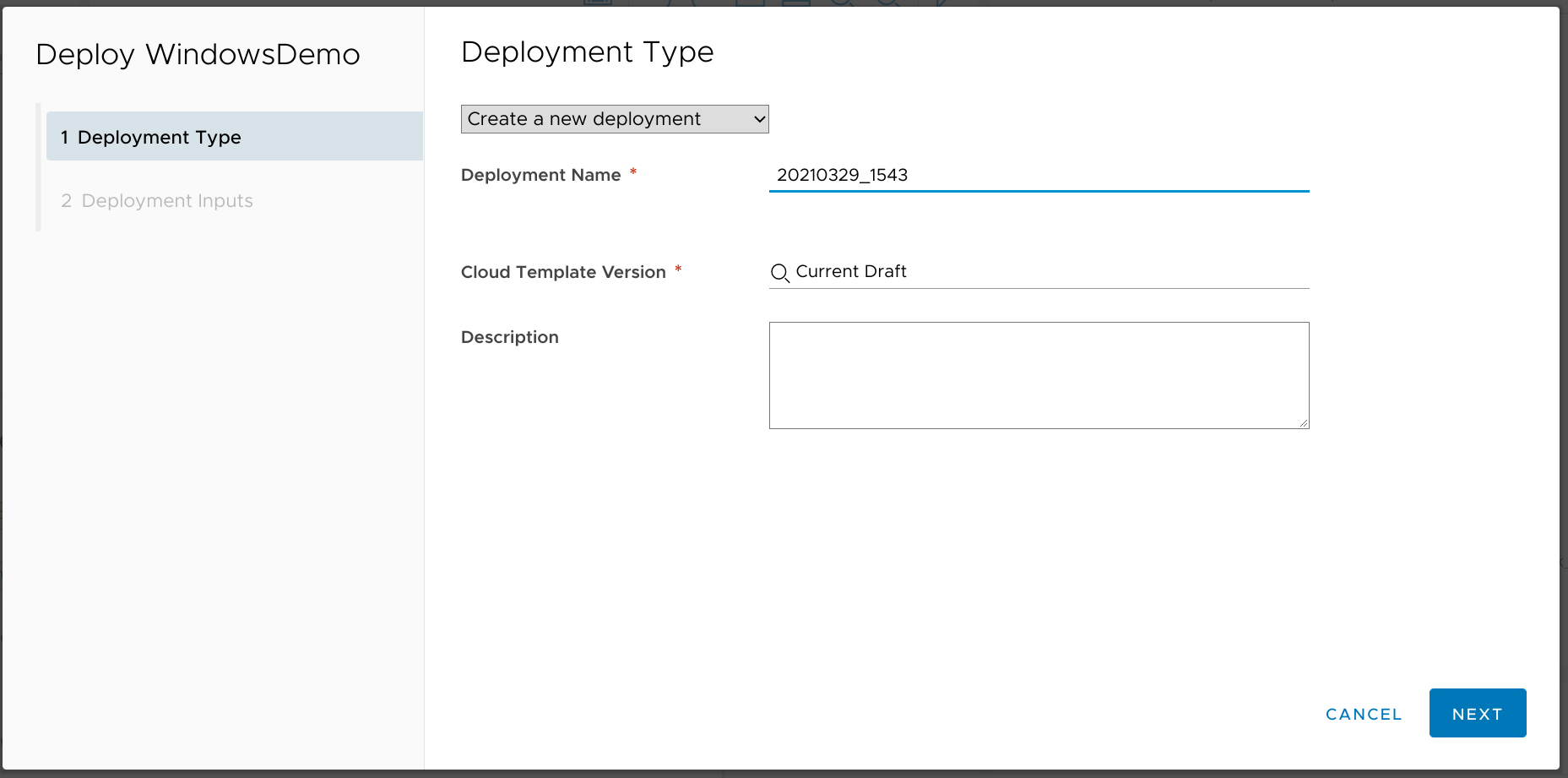
Each deployment has to have a unique deployment name. I got tired of trying to keep up with what names I had already used so kind of settled on a [DATE]_[TIME] format for my test deployments. I'll automatic this tedious step away in the future.
I then confirm that the (automatically-selected default) inputs are correct and kick it off.
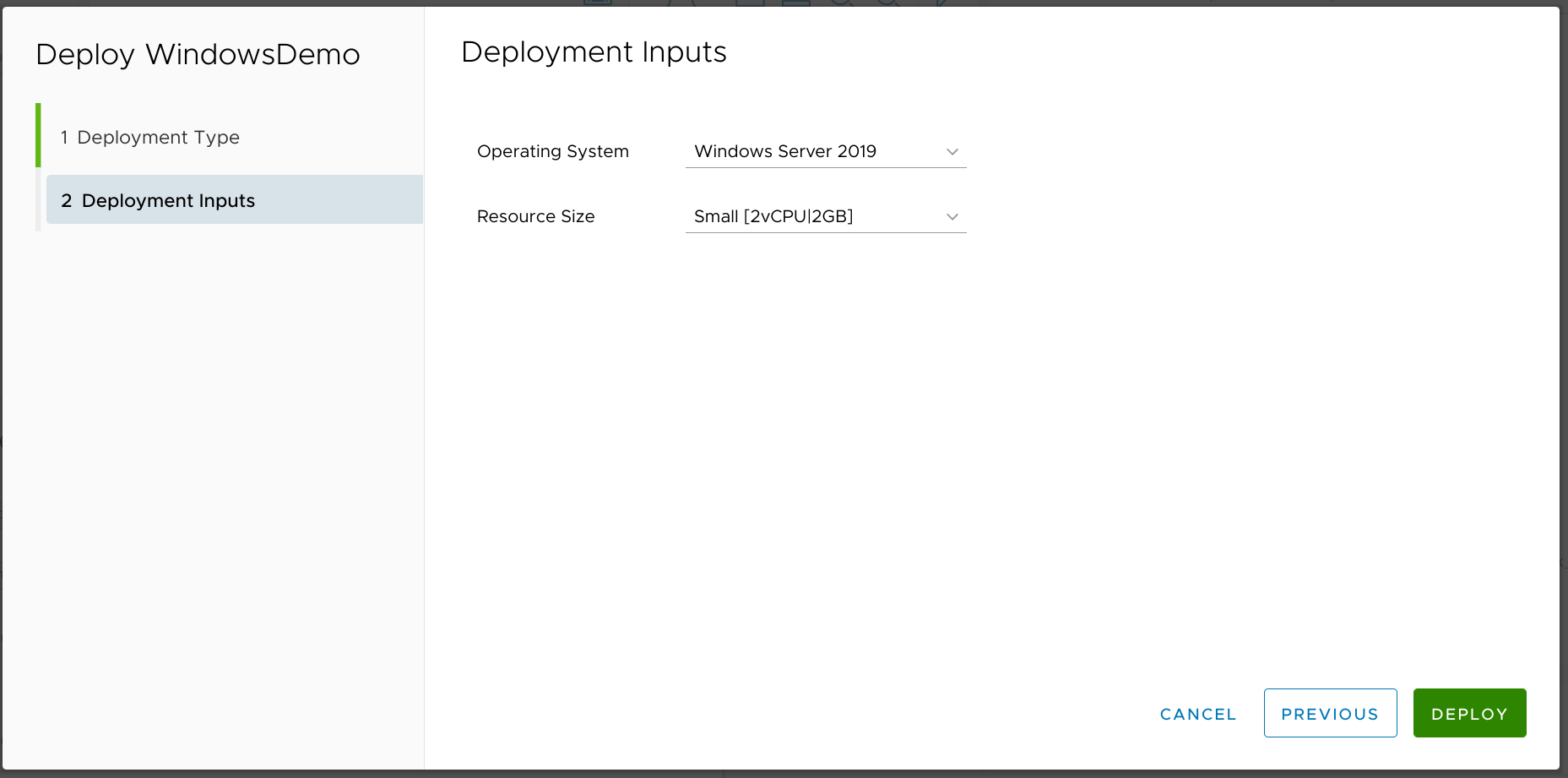
The deployment will take a few minutes. I like to click over to the History tab to see a bit more detail as things progress.
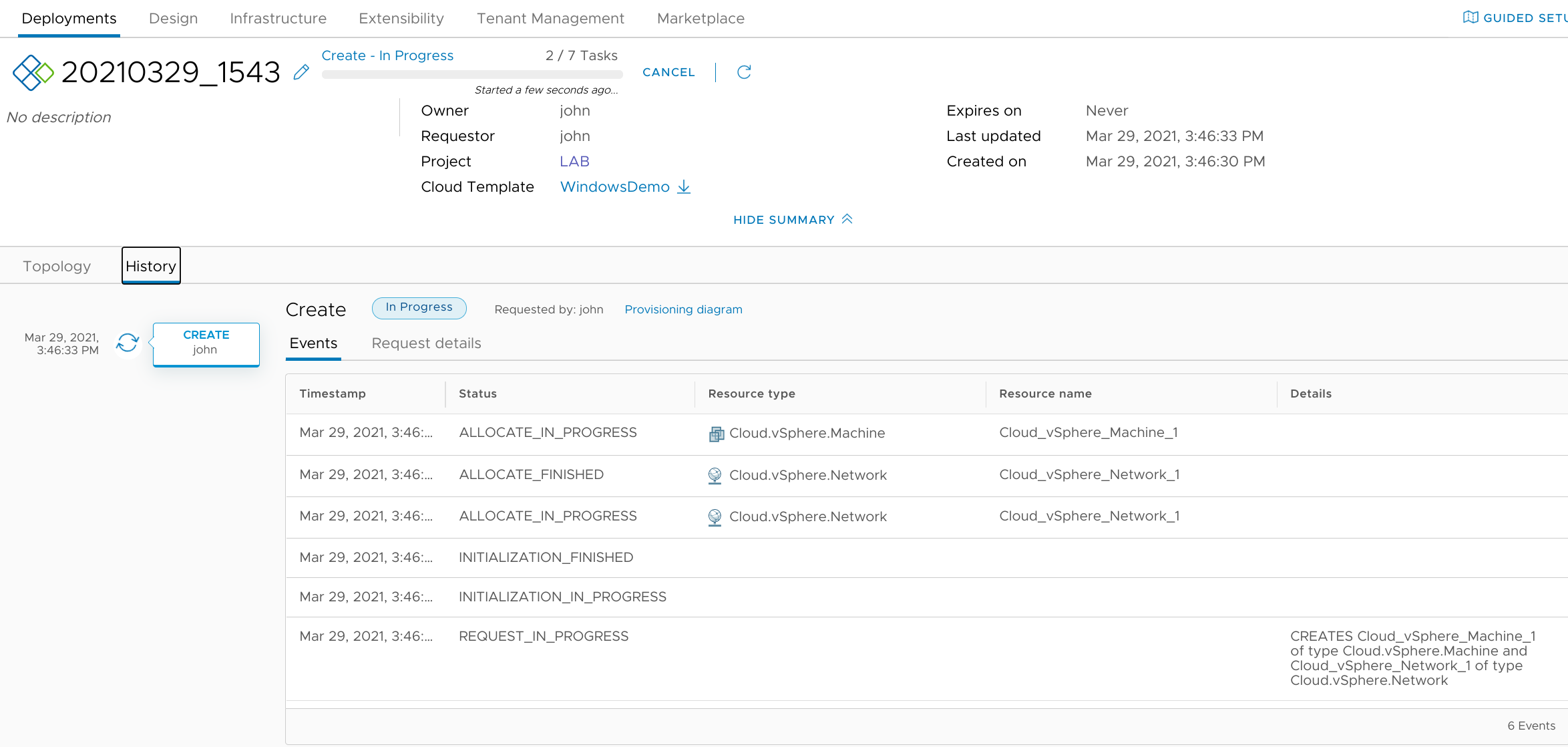
It doesn't take too long for activity to show up on the vSphere side of things:
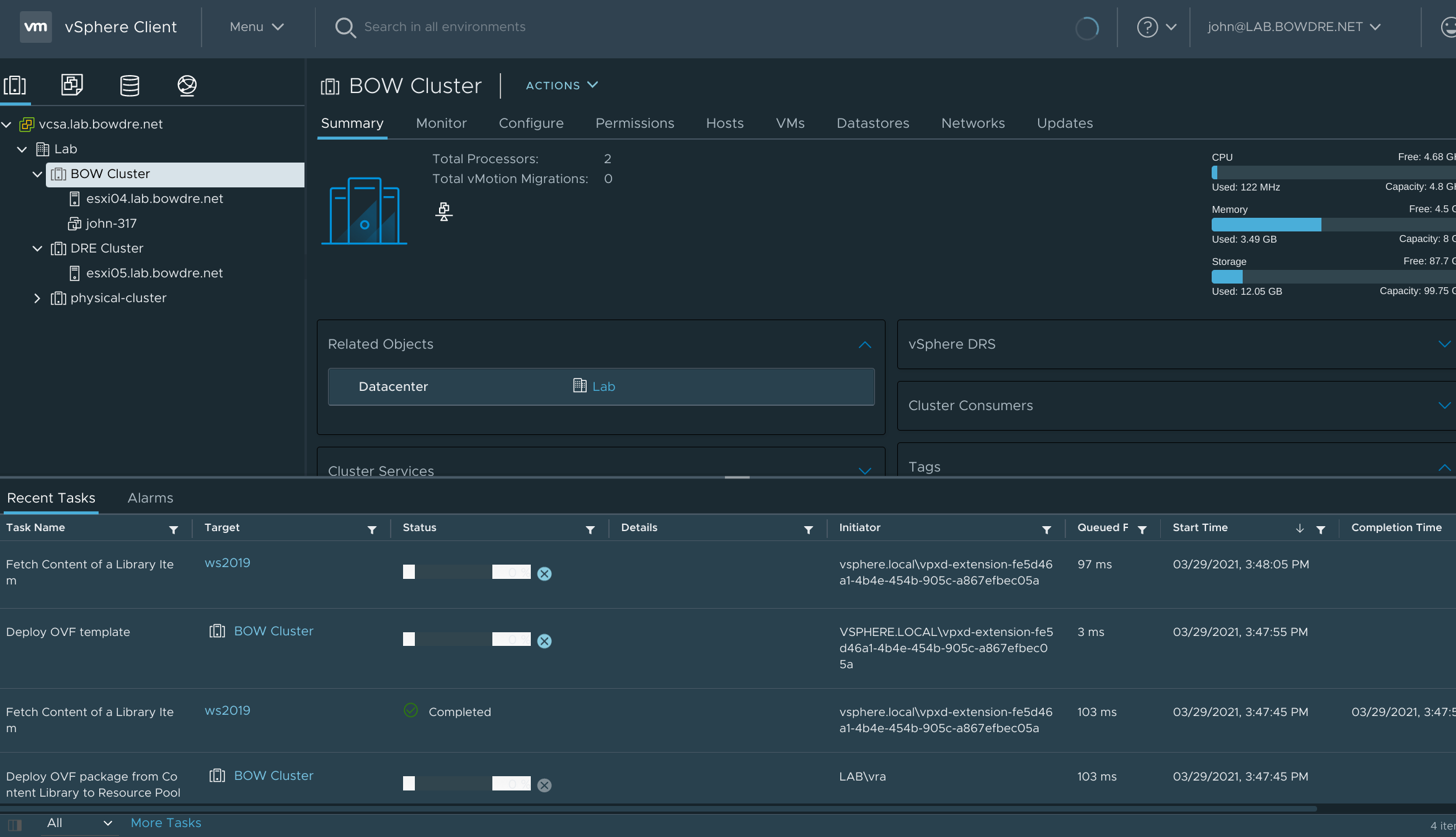
And there's the completed VM - notice the statically-applied IP address courtesy of {php}IPAM!
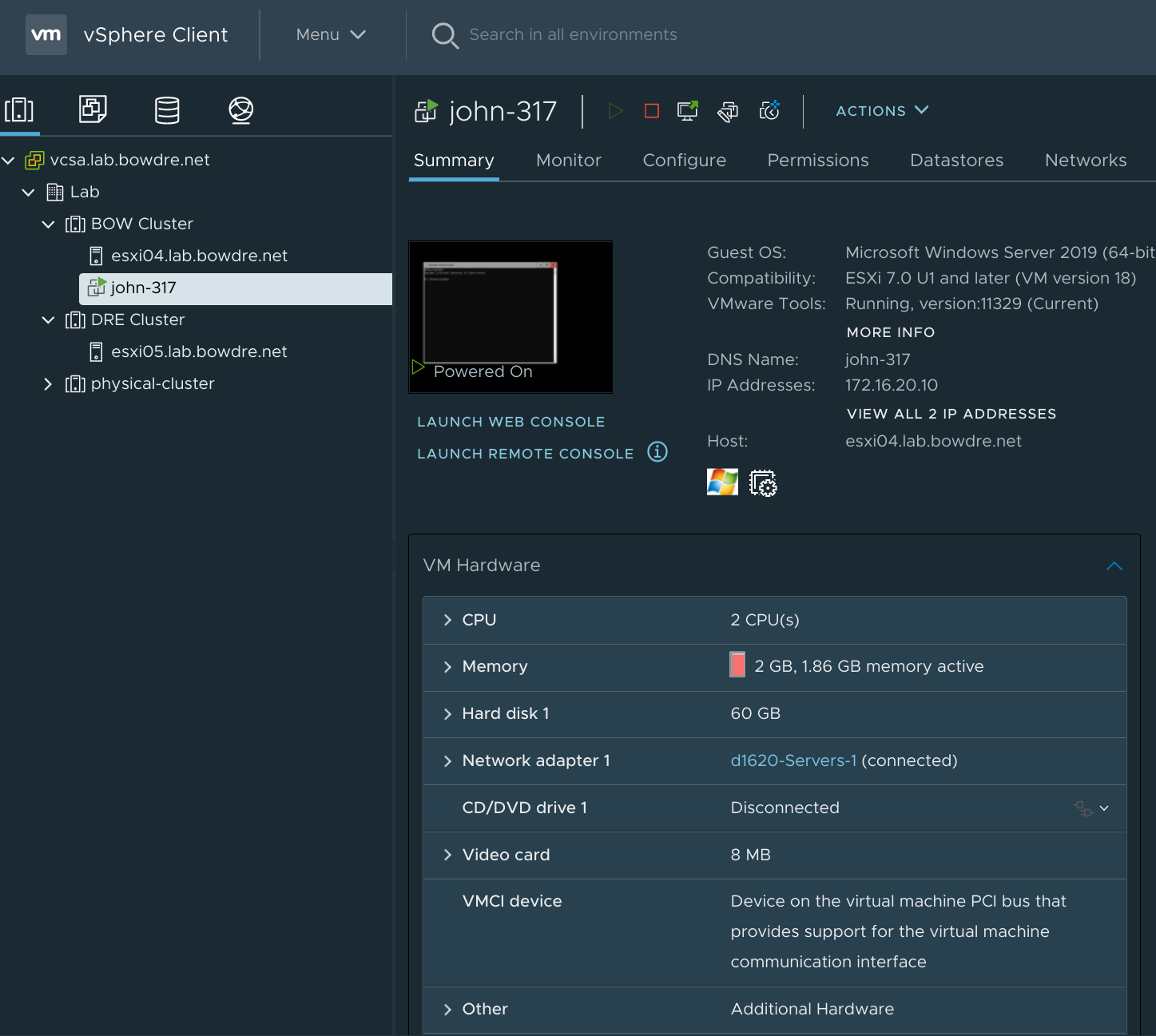
And I can pop over to the IPAM interface to confirm that the IP has been marked as reserved as well:
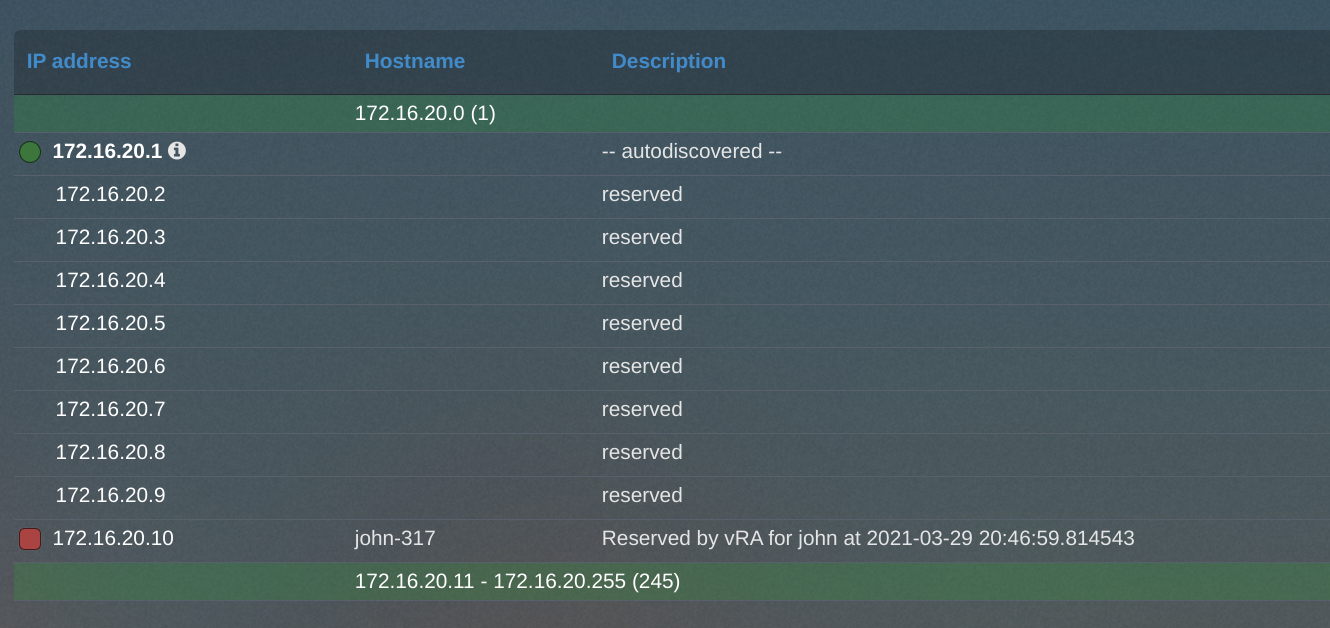
Fantastic! But one of my objectives from earlier was to let the user control where a VM gets provisioned. Fortunately it's pretty easy to implement thanks to vRA 8's use of tags.
Using tags for resource placement
Just about every entity within vRA 8 can have tags applied to it, and you can leverage those tags in some pretty creative and useful ways. For now, I'll start by applying tags to my compute resources; I'll use comp:bow for the "BOW Cluster" and comp:dre for the "DRE Cluster".
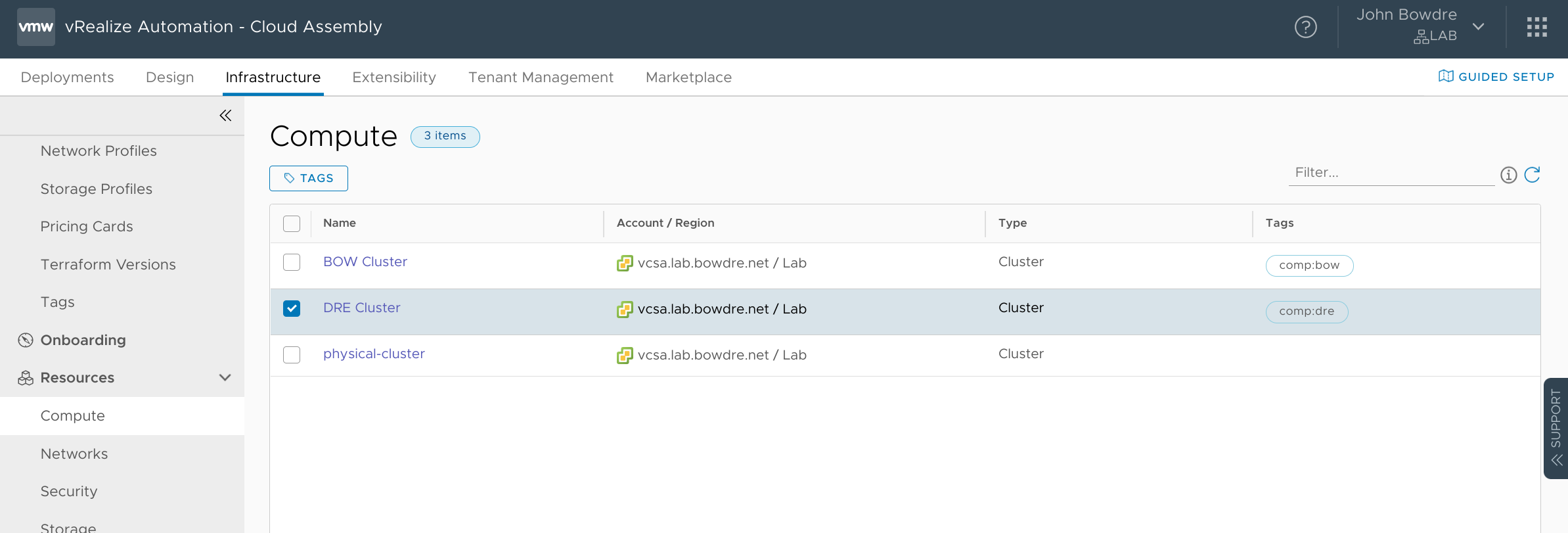
I'll also use the net:bow and net:dre tags to logically divide up the networks between my sites:
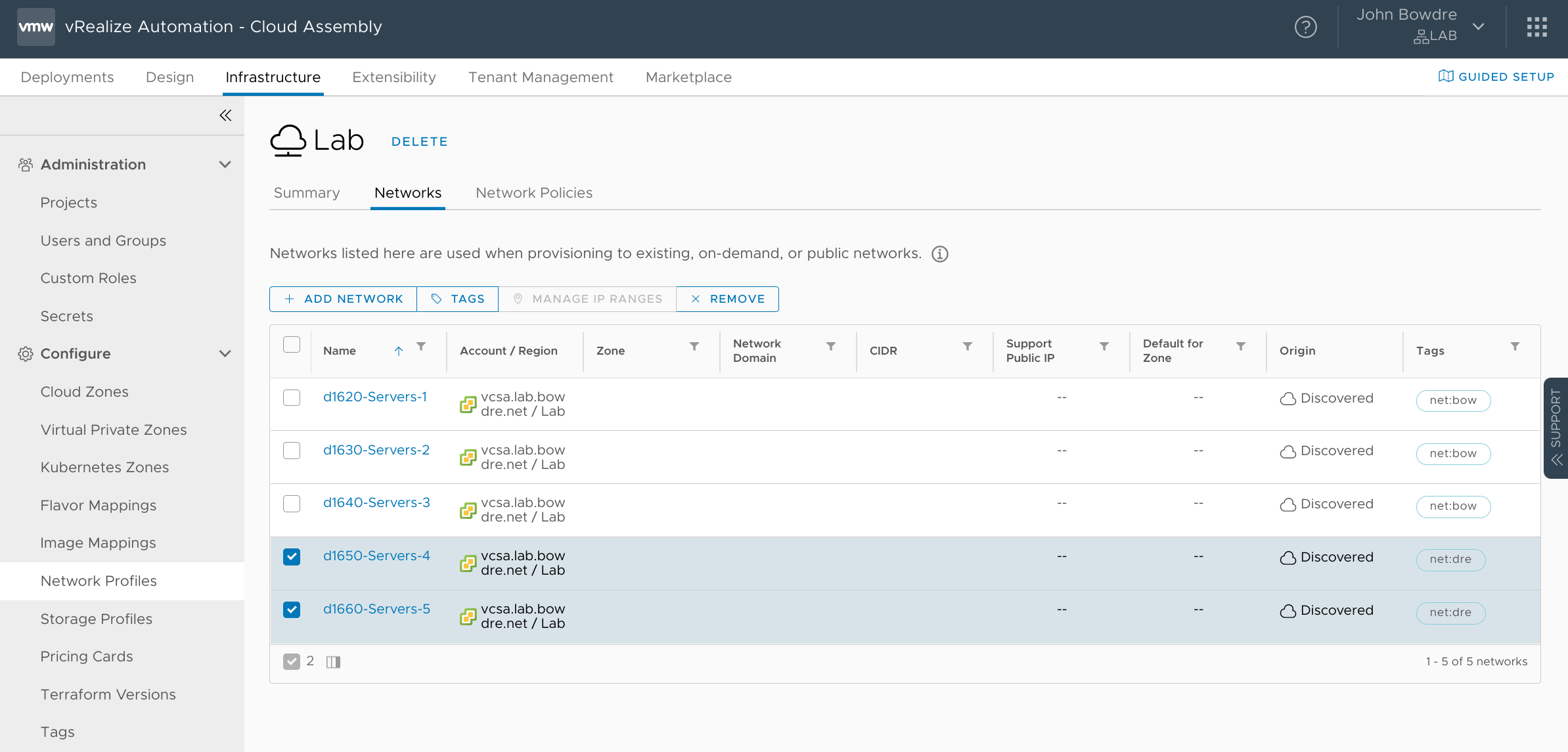
I can now add an input to the Cloud Template so the user can pick which site they need to deploy to:
# torchlight! {"lineNumbers": true}
inputs:
# Datacenter location
site:
type: string
title: Site
enum:
- BOW
- DRE
# Image Mapping
I'm using the enum option now instead of oneOf since the site names shouldn't require further explanation.
And then I'll add some constraints to the resources section, making use of the to_lower function from the cloud template expression syntax to automatically convert the selected site name from all-caps to lowercase so it matches the appropriate tag:
# torchlight! {"lineNumbers": true}
resources:
Cloud_vSphere_Machine_1:
type: Cloud.vSphere.Machine
properties:
image: '${input.image}'
flavor: '${input.size}'
networks:
- network: '${resource.Cloud_vSphere_Network_1.id}'
assignment: static
constraints:
- tag: 'comp:${to_lower(input.site)}'
Cloud_vSphere_Network_1:
type: Cloud.vSphere.Network
properties:
networkType: existing
constraints:
- tag: 'net:${to_lower(input.site)}'
So the VM will now only be deployed to the compute resource and networks which are tagged to match the selected Site identifier. I ran another test to make sure I didn't break anything:
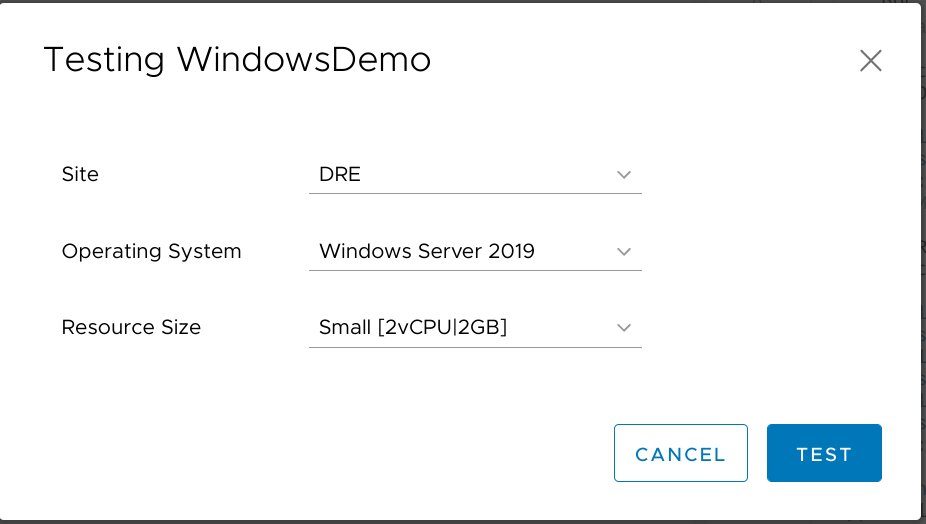
It came back successful, so I clicked through to see the provisioning diagram. On the network tab, I see that only the last two networks (d1650-Servers-4 and d1660-Servers-5) were considered since the first three didn't match the required net:dre tag:
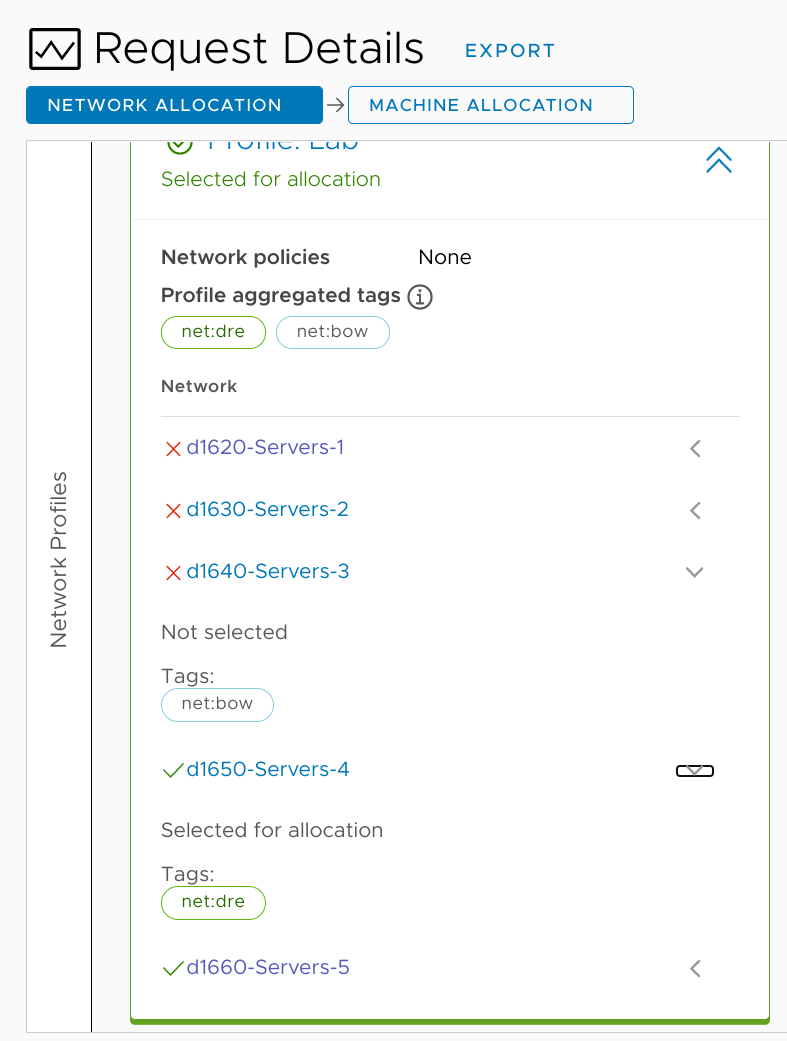
And it's a similar story on the compute tab:
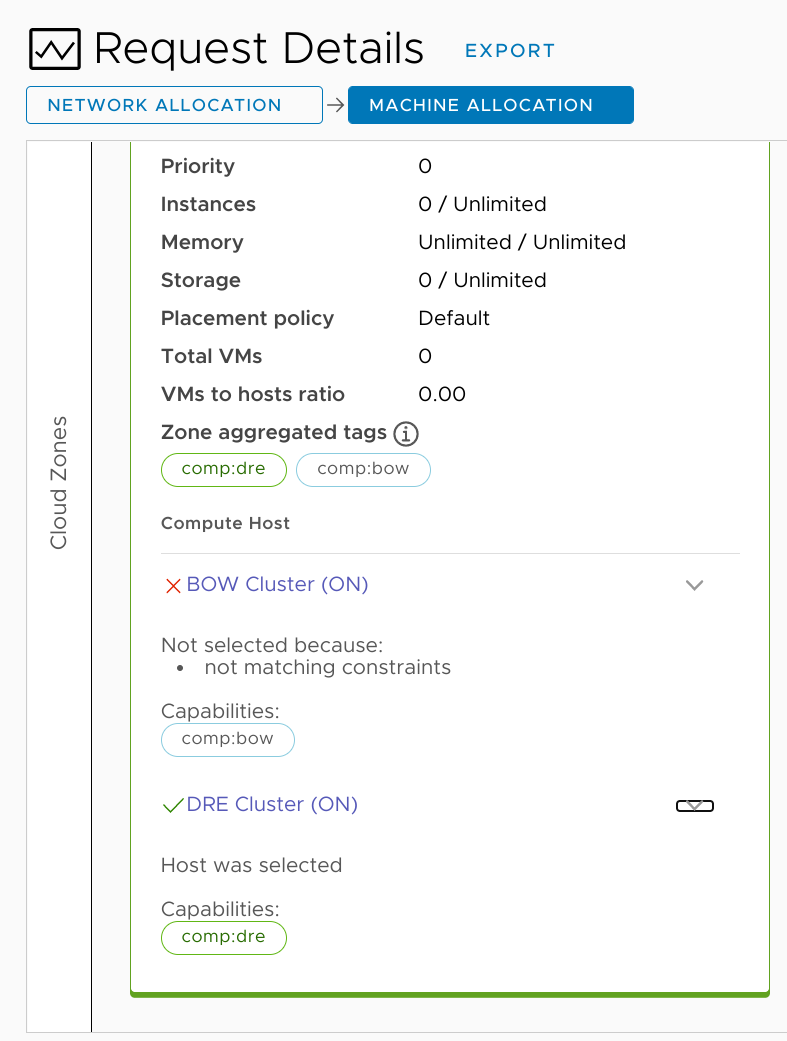
As a final test for this change, I kicked off one deployment to each site to make sure things worked as expected.
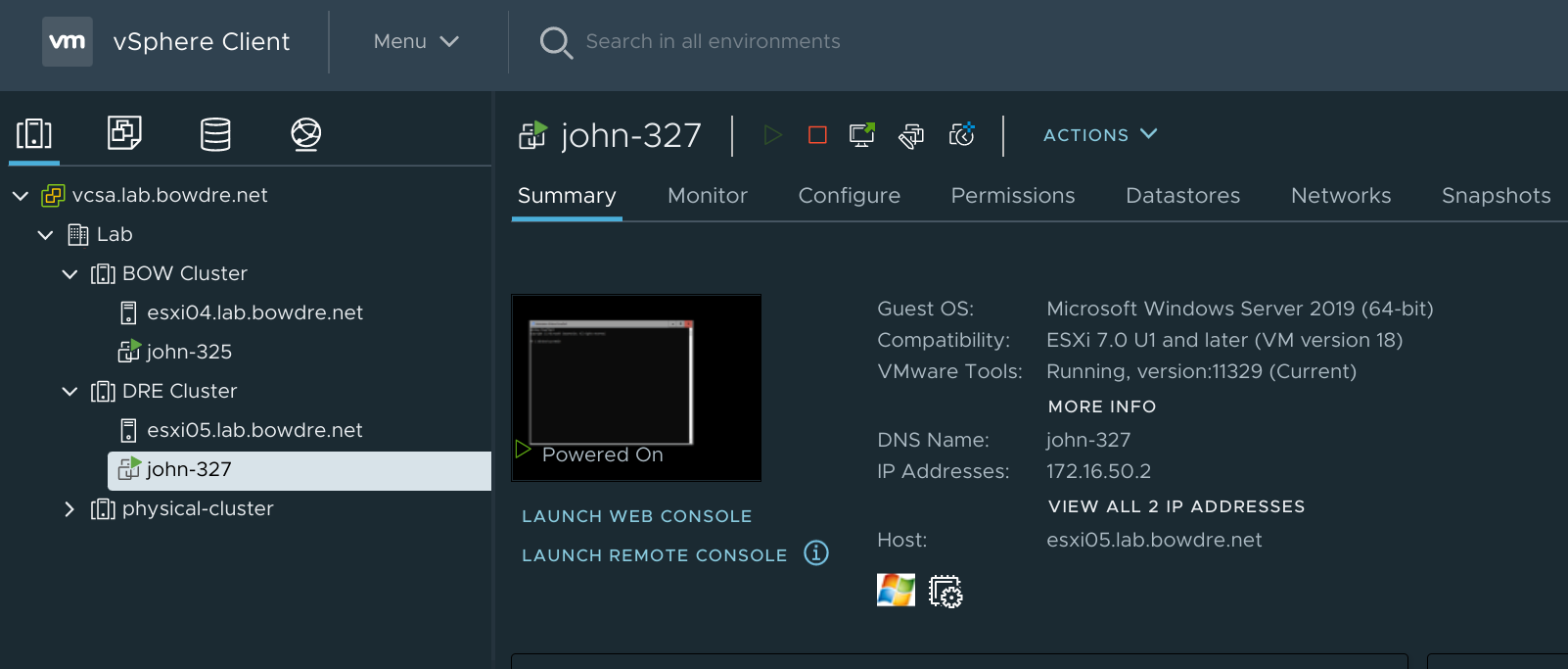
Nice!
Conclusion
This was kind of an easy introduction into what I've been doing with vRA 8 these past several months. The basic infrastructure (both in vSphere and vRA) will support far more interesting and flexible deployments as I dig deeper. For now, being able to leverage vRA tags for placing workloads on specific compute resources is a great start.
Things will get much more interesting in the next post, where I'll dig into how I'm using vRealize Orchestrator to generate unique computer names which fit a defined naming standard.